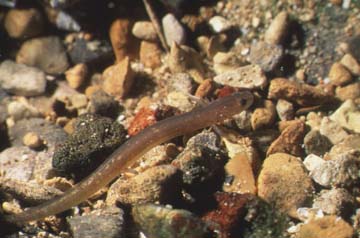San Marcos Salamander (Eurycea nana)

TPWD ©
- Texas Status
- Threatened
- U.S. Status
- Threatened, Listed 7/14/1980
- Description
- The San Marcos salamander is a dark reddish-brown salamander about 1 to 2 inches long, small and slender.
- Life History
- The San Marcos salamander occurs only in Spring Lake and an adjacent downstream portion of the upper San Marcos River. Moss and algae provide hiding places for the salamanders and habitat for small animals that serve as their food. The dark reddish-brown color of the algae almost perfectly matches the dark color on the back of the San Marcos Salamander. These salamanders do not occur where the bottom is muddy or bare. Clean, clear, flowing water of constant temperature is required for suitable habitat. It eats tiny aquatic crustaceans, aquatic insects, and snails. Females lay eggs singly or in small groups, eggs are attached to plants or under rocks. This aquatic salamander has external gills which are retained throughout life.
- Habitat
- Clear, flowing spring water coming from the headwaters of the San Marcos River provide habitat for the San Marcos salamander.
- Distribution
- It is found only in the San Marcos River, Hays County, Texas.
- Other
- Reduced flow of water from the springs is the greatest threat to the survival of the San Marcos Salamander and other animals and plants dependent on the springs. The growth of cities has led to higher water use by people and increased problems with water pollution and silt accumulation. Introduction of non-native species is also a threat because they may destroy aquatic vegetation, prey on endangered animals, or compete with them for food.
For more information